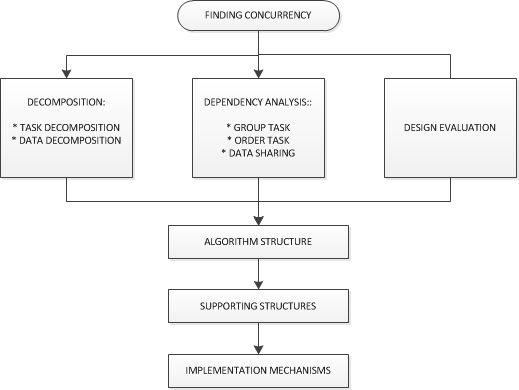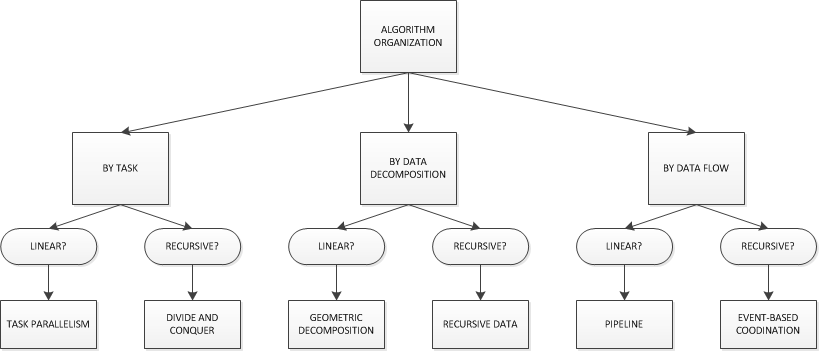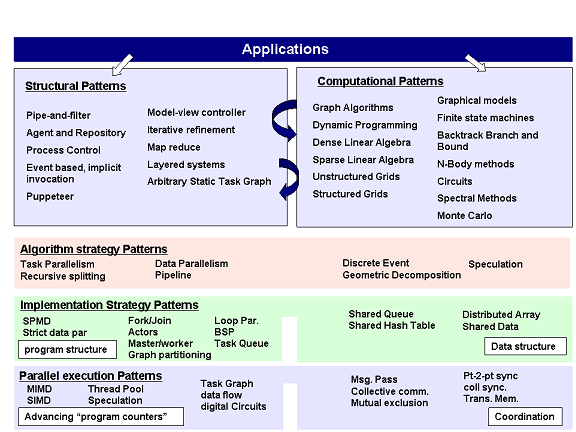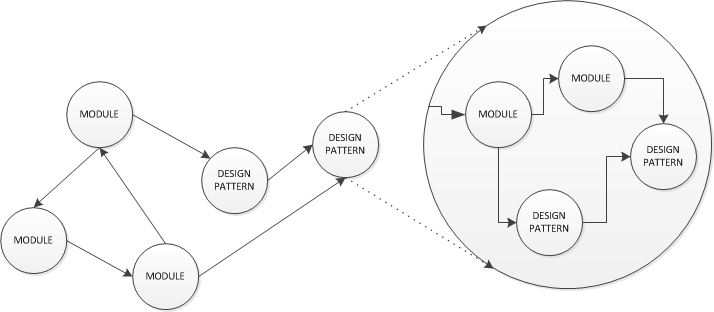CSC/ECE 506 Spring 2012/3a kp: Difference between revisions
| Line 311: | Line 311: | ||
6. "Building Parallel Applications using Design Patterns", Dhrubajyoti Goswami, et al. | 6. "Building Parallel Applications using Design Patterns", Dhrubajyoti Goswami, et al. | ||
7. "Design Patterns for Parallel Programming" - S. Siu, M De Simone, D Goswami, A Singh | |||
== Links == | == Links == | ||
Revision as of 15:34, 12 February 2012
Patterns of parallel programming
Overview
A design pattern is a description of a solution to a frequently occurring problem in some domain. The description makes it easy for the reader to quickly understand both the problem and the proposed solution. Because the pattern has a name, a collection of patterns provides a vocabulary with which to talk about these solutions. They were first postulated for City Planning applications, but they promptly extended to Computer Science (http://en.wikipedia.org/wiki/Software_design_pattern). The idea would always be to have a library of reusable resources that would help us in the development of our product.
As an example – “Dense Linear Algebra” is a “Computational” design pattern for parallel programming. Under this pattern a computation is organized as a sequence of arithmetic expressions acting on dense arrays of data. The operations and data access patterns are well defined mathematically so data can be prefetched and CPUs execute close to their theoretically allowed peak performance.
Parallel programming design patterns have been identified at various levels of software development from high-level patterns that describe how an application is organized to midlevel patterns about specific classes of computations, and low level patterns describing specific execution strategies. Related to these classifications, there are also available “pattern languages” from several researchers, that guide the software developer through hierarchy of parallel programming design development.
In this article we first cover three “pattern languages” for parallel programming in some detail. These are attempts to classify these patterns and we then dwell on commonalities between these approaches. Thereafter, we cover a broad range of parallel programming design patterns highlighting the commonalities and differences.
It is important to appreciate that many design problems do not lend themselves to a top-down or bottom-up analysis. In many cases, the pathway through our patterns will be bounce around between layers with the designer working at whichever layer is most productive at a given time.
Parallel Pattern Programming Languages
We next review "Parallel Pattern Programming Languages" from two researchers and discuss their commonalities and differences.

1. Classification by B.L.Massingelllink
This considers four levels of patterns design - A) Finding Concurrency B) Algorithm Structure C) Supporting Structures D) Implementation Mechanisms

A) "FindingConcurrency” considers high-level issues to expose potential concurrency. There are three major design patterns at this level –
i) Decomposition Strategy pattern - focuses on decomposing the problem into parts that can be run simultaneously and also includes “Task Decomposition pattern” (decomposing into concurrent tasks) and “Data Decomposition pattern” (decomposing into data units that can be run independently).
ii) Dependency Analysis – After using "Decomposing Strategy Pattern" to break into entities, the dependency analysis pattern help the programmer understand how they depend on each other. These dependencies include “Grouping Tasks” (to simplify dependency), “Ordering Tasks” (to satisfy constraints) and “Data Sharing” (among tasks).
iii) Design Evaluation – This pattern is a consolidation pattern; it is used to evaluate the results of the other patterns in this design space.

B) Algorithm Structure – This steps moves close to the final program and has six Patterns in three sub-groups -
i) Organize by flow of data – Pipeline Processing Pattern (decomposing into ordered tasks groups connected by data dependencies) and Asynchronous Decomposition Pattern(decomposed into task groups that interact through asynchronous events).
ii) Organize by tasks – Embarrassingly Parallel Pattern (decomposing into a set of independent tasks) and Divide-and-conquer Pattern (break the problem into subproblems that are solved separately and then recombined later).
iii) Organize by data – Geometric Decomposition Pattern (decompose and solve problem into discrete subspaces with the solution for each subspace typically requiring data from a small number of other subspaces) and Recursive Data Pattern (problem is defined in terms of following links through a recursive data structure).

C) The Supporting Structures design space-
The intermediate stage between algorithm structure design space and the machine-oriented “patterns” of the implementation mechanisms space has two types of patterns i) program-structuring constructs and ii) shared data structures. Program-structuring constructs include master/worker (a master process managing worker processes)/ SPMD (Single Program Multiple Data - similar to master/worker with no explicit master process), loop parallelism (distributing parallel loops processing) and Fork/Join (distribution of dynamically created tasks among processing units). Shared data patterns include - ‘shared data’ (explicit shared data among concurrent tasks), ‘shared queue’ (sharing of queue data structure among concurrent tasks), distributed array (distribution of arrays among multiple processing units).
D) The Implementation Mechanisms design space –
These patterns deal with common mechanisms for process or thread management (e.g., creating or destroying processes or threads), synchronization to enforce order of events (memory fences, barriers, mutual exclusion, monitors, semaphores) and communication (e.g., message-passing and collective communication).
2. Classification by Keutzer and Mattson [1]

They define the application in terms of structural pattern (that define overall organization) and computational patterns at the top to low level details of parallel algorithm at the bottom.
A) The "structural and computational patterns" at the top are tightly coupled and a designer may iterate among them. In other words, a designer thinks about his or her problem, chooses a structure pattern, then considers the computational patterns required to solve the problem. The selection of computational patterns may suggest a different overall structure for the architecture and force a reconsideration of the appropriate structural patterns. This process, moving between structural and computational patterns, continues until the designer settles on a high level design for the problem.
The top level “Structural Pattern” and “Computational Pattern” correspond to “Finding Concurrency” in B.L. Massingell’s classification. The emphasis is on strategically overviewing the problem to find concurrency.
B) The algorithm strategy pattern at the next level is also very similar to Massingell's "Algorithm Structure". These deal with organizing by tasks (Tasks Parallelism, Recursive Splitting), data (Data Parallelism, Geometric Decomposition) and flow of data (Pipeline, Speculation, Discrete Event).
C) At the bottom two levels “Implementation Strategy” and D) “Parallel Execution Strategy” correspond very closely to the last two design patterns levels in B.L.Massingell. The “Implementation Strategy” deals with “Program Structure” and “Data Structure” patterns, while the “Parallel Execution Strategy” deals with task/creation process and management of communication between tasks.
In summary, there appears a commonality in thinking in classifying design patterns for parallel programming.
2. Classification by Siu et all [2]

Another line of parallel programming proposed by Siu et all implies the use of so-called skeletons as the building blocks for fast and reliable parallel code. The system provides interfaces to connect patterns that can be reused and interchanged, so the programmer not only has a library of resources, but can experiment with different methods with more ease and time savings. The technique exploits the fact that the patterns have common structures but lack the procedures that are specifics to the applications. The model represents applications with graphs with the nodes being either a sequential computation or a design pattern. Each of these nodes could be or have a subgrapgh itself. It has the following components:
A) User Interface: where the user introduces and specifies the graphs to be used.
B) Design Pattern libraries: where the design patterns are located, typically as classes.
C) Code Skeleton generator and supporting libraries.
The First Level - Decomposition Strategy Patterns
In this section we cover, the decomposition strategy using Structural and Computational Design pattern. While a many of these patterns may appear familiar, however we emphasize the relevance of these paradigms in the parallel programming context i.e. in splitting the software design into sub-tasks that can be run in parallel.
Structural Pattern is a high level view of program design. These represent "box and arcs" a software architect would draw on a whiteboard in describing an application. The "boxes" of the diagram represent the "computational" kernels. The problem may be viewed in terms of any of the structures patterns described in the glossaryGlossary. Identifying the pattern of the problem automatically points to parallelization that is possible. For example -
- pipe-and-filter views a problem as a series of processing boxes with inputs and outputs. Each of the processing box may be run concurrently/in parallel.
- agent-and-repository - views a problem as many independent agents/processes acting on a central data repository. Each of the agents/processes may be run in parallel under the control of a manager.
- process control - views a state being monitored continuously and actions being taken based on the monitor results. The actions may be run concurrently/in parallel.
- event based implicit invocation - this pattern involves agents reacting to events and generating events. This is quite easily amenable to be handled by parallel processors, since handling many events may be viewed as parallel tasks.
- model-view-controller - the roles of data processing, controlling the data processing and interaction with the user may be easily separated among different processing functions that may be run in parallel.
- iterative refinement - An example of this is the ocean problem covered in the class. A process to refine the solution iteratively may be broken out among the parallel tasks e.g. red and black dot and anti-parallel processing for the ocean problem.
- map-reduce - involves mapping a single function to independent data sets and reducing these execution to solution. the task of running and reducing may be run in parallel.
- puppeteer - involves several agents running in parallel and managed by a puppeteer
- arbitrary static task graph - is the most general pattern (when nothing else fits) with a general break-up of problem into tasks that may potentially be run in parallel.
Computational Patterns They are the structural patterns that describe and represent our application and the operations that it comprehends, that is, the building blocks we can divide it upon to be implemented. They can normally be split into smaller patterns in a hierarchical fashion and be adapted to particular hardware and software architectures. At times, the definition of the computational patterns takes to further iterations of other levels of patterns, most commonly the structural ones, as the software architects start pealing through the layers of the application. Some examples of this -
- Backtrack, branch and bound: these are decision patterns that look for values in the history of a group of variable and act according to their value. They will become ours if, switch or threads.
- Circuits, where the components are Boolean in fashion, like memory, or flip-flops.
- Dynamic programming, which are the typical problems of "size N". It is important to define these structures well to get the best parallelisms. These cases are normally traverses or searches.
- Linear algebras, where the problems can be organized in mathematical structures, like for instance matrices, and arithmetic expressions. They can be spares or dense, depending if their elements are mostly zeroes or not. Their operations are typically well defined and data can be prefetch, which means normally many opportunities for finding ways to repetition, iteration and parallelization.
- Automatas and Finite State Machines, where the inputs are treated with machines that can be virtual or not. Associated often to hardware, like FPGAs, they are also common in software, like regular expressions, or simulations. Parallelization will strongly depend on the architecture of the machine that manages the application.
- Graphical Algorithms and Models, that comprehend all cases where the applications are better represented as graphs. These graphs nodes, vertices and edges and can be object of a number of operations, like traversing, that can be easily parallelized.
- Approximations, like Montecarlo, where we use sampling or other approximation techniques, that can allow us to analyze a problem with a reduce complexity.
- Transformations: where the data is transformed so it can be analyzed or processed in a better way using some mathematical techniques, like, for instance, using a Fourier transform. This process presents lots of opportunities to find parallelization.
- Meshes, which can be structured or not, depending on the geometrical coupling between their components. Meshes are systems that are defined geometrically and are represented by a system of equations.
The Second level - Algorithm Strategy Patterns
Once a structural/computational pattern has been identified there may be a variety of algorithms that may be used. The concurrencies are more directly identified at this stage.
The most common algorithm stratgy pattern include -
- Task parallelism - Simply means running independent tasks parallely example of this is embarrasingly parallel pattern.
- Pipeline - Running serial operations on a series of data set in parallel because one data set item does not need to wait for the operations to finish on the data item ahead.
- Discrete event - Multiple tasks interacting via an event handler with event handling by each tasks run parallely.
- Speculation - Speculatively and parallely run a series of tasks ahead and commit some of the parallel task as required by the outcome of previous step.
- Data parallelism -A single stream of instructions is applied to each element of data structure.
- Recursive splitting - Recursively generated task can be optmized by assigning these to parallel processing, using a balanced data structure/fork-join or task queue implementation and improving locality.
- Geomertic decomposition - Breaks the problem into data chunks with each each data chunk processed parallely and data chunks exchanging data at boundaries.
The Third Level - Implementation Strategy Patterns
Here is where the system adapts to the application, and vice-versa. It is in plain words the source code and includes its organization and that of the structures that we need to carry it on. This level is where we define how the threads of our code are going to be executed, and it is where we may map and implement the concurrences that we have found in the upper levels in software procedures. We will have a choice of software kind and language that will determine how our concurrency gets implemented. There are two main groups, depending on what the scope of the pattern is: program structure patterns and data structure patterns.
Program structured:
- Single Program Multiple Data, where a single operation is performed over many sets of data and the programs have many instances. These are the patterns to define process and threads IDs and ranks.
- Data Parallel Strictly comprehends a big set of patterns and algorithms for concurrent operations with data.
- For/Join are thread mechanisms, where tasks are created in parallel, executed and them put together with a joining function.
- Actors are objects, which include variables and their operations and normally interact with message passing.
- Master-workers is an architecture where a central process would be assigning the tasks to its "workers", parallel processing elements, that would return the results to the master when finished, and be assigned a new task.
- Task Queues, where the tasks that are running in parallel are independent and can be organized in queues and taken by the scheduler. Similar to master-workers, but with no "master" overhead or limited to a single "master" thread.
- Graph partitioning, oriented to exploit concurrency in graphs.
- Loop-level parallelism, or patterns that deal with computing intensive loops and how to take advantage of the application particularities to optimize parallelism. OpenMP falls in this bucket.
- Computational structures, like BSP, where the system is organize in steps, each one of it with local data access.
Data structures:
- Shared queues:
- Distributed Arrays
- Shared hash tables
- Shared data
The Fourth Level - Parallel Execution Patterns
These patterns deal with how a parallel algorithm is translated into software elements to fully exploit the specific hardware elements. . They are the strategies and facilities to build, support and synchronize our tasks. These include - (1) Process and thread control patterns (2) Coordination pattern
Process and thread controls patterns advance a program counter -
- MIMD pattern - Multiple process with each one acting on their own data and coordinating communication through discrete events
- Data flow - Computation steps are viewed as direct acylice graph of thread that are mapped to parallel computers
- SIMD pattern - Single Stream of instructions is applied to multiple data on different processing elements
- Thread pool - Rather than creating and destroying threads (which are expensive operations), a pool of threads is maintained. A thread is returned to a pool after use and steals works to ensure a balanced work load
- Speculative execution - Compiler or runtime system is enabled to do speculative executions and to roll back those executions that are not required
- Digital circuits - Functionality is hard wired for concurrency in digital circuits and available as separate instruction set.
Patterns that deal with coordination of threads or processes are well known ones -
- Message passing - Passing messages between process that need to be synchronized
- Collective Communication - Message is passed to a group of (rather than individual) threads. Example reductions, broadcasts, prefix sums, and scatter/gather
- Mutual exclusion - Block of code or memory that can be exeucted by one process at a time
- Point-to-point and collective synchronization - Mutex locks to enforce order of events for two threads or a collection of threads.
- Transactional memory - Folds into memory to detect access conflicts and roll back transactions when a conflict occurs. This is speculative parallelism and effective when conflicts are rare
Glossary Of Patterns
Structural Patterns
i) Pipe-and-filter ii) Agent-and-repository iii) Process control iv) Event-based-implicit invocation v) Model-view-controller vi) Iterative refinement vii) MapReduce viii) Layered systems ix) Puppeter x) Arbitrary static task graph
Computational Patterns
i) Backtrack, branch and bound ii) Circuits iii) Dynamic programming iv) Dense linear algebra v) Sparse Linear Algebra vi) Finite state machine vii) Graph algorithms viii) Graphical models ix) Monte Carlo x) N-body xi) Spectral methods xii) Structured mesh xiii) Unstructured mesh
Algorithm Strategy Patterns
i) Task parallelism ii)Pipeline iii) Discrete event iv) Speculation v) Data parallelism vi) Recursive splitting vii)Geometic decomposition
Implementation strategy patterns
Structured as a Program:
i) Single-Program Multiple Data (SPMD) ii) Strict data parallel iii) Fork/join iv) Actors v) Master-worker vi) Task queue vii) Graph Partitioning viii) Loop-level parallelism ix) BSP
Structured as Data:
i) Shared queue ii) Distributed array iii) Shared hash table iv) Shared data
Parallel Execution Patterns
With program counter advance:
i) MIMD ii) Data flow iii) SIMD iv) Thread pool v) Speculative execution vi) Digital circuits
Thread coordinated:
i) Message passing ii) Collective communication iii) Mutual exclusion iv) Point to point synchronization v) Collective synchronization vi) Transactional memory
References
1."Parallel Programming with a Pattern Language", Berna Massingill, et al.
2."Parallel Numerical Methods - Multigrid", Michael Heath
3."Distributed Dynamic Data-Structures for Parallel Adaptive Mesh-Refinement", Manish Parashar, et al
4."ZPL Implementation of AMR Algorithm for Elastic Wave Propagation", Hongyu Wu, et al.
5."Reinventing Explicit Parallel Programming for Improved Engineering of High Performance Computing Software", Anthony Skjellum, et al.
6. "Building Parallel Applications using Design Patterns", Dhrubajyoti Goswami, et al.
7. "Design Patterns for Parallel Programming" - S. Siu, M De Simone, D Goswami, A Singh
Links
1. Resources on Parallel Pattern
2. A pattern language of parallel programming
3. [http://parlab.eecs.berkeley.edu/wiki/patterns/patterns/Link A Pattern Language for Parallel Programming ver2.0 ]
4. [http://msdn.microsoft.com/en-us/library/dd492418.aspx/Link Parallel Patterns Library (PPL) ]